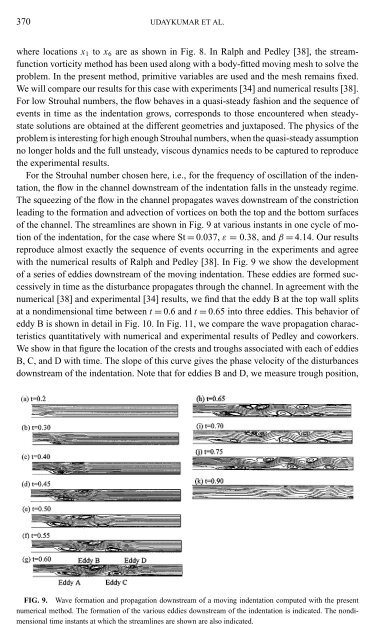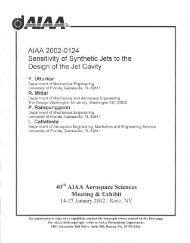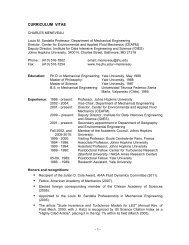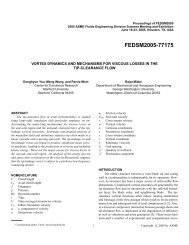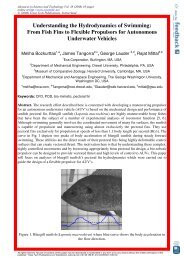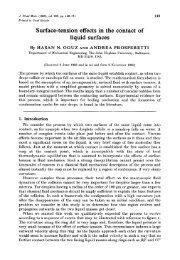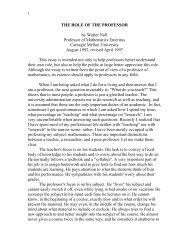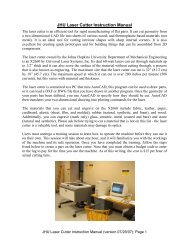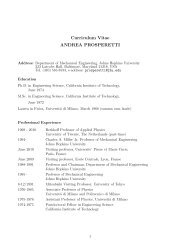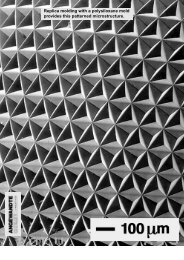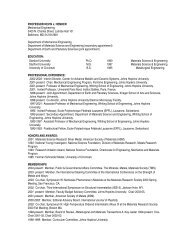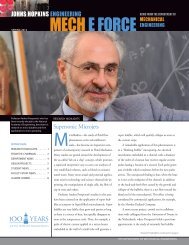A Sharp Interface Cartesian Grid Method for Simulating Flows with ...
A Sharp Interface Cartesian Grid Method for Simulating Flows with ...
A Sharp Interface Cartesian Grid Method for Simulating Flows with ...
Create successful ePaper yourself
Turn your PDF publications into a flip-book with our unique Google optimized e-Paper software.
370 UDAYKUMAR ET AL.<br />
where locations x 1 to x 6 are as shown in Fig. 8. In Ralph and Pedley [38], the streamfunction<br />
vorticity method has been used along <strong>with</strong> a body-fitted moving mesh to solve the<br />
problem. In the present method, primitive variables are used and the mesh remains fixed.<br />
We will compare our results <strong>for</strong> this case <strong>with</strong> experiments [34] and numerical results [38].<br />
For low Strouhal numbers, the flow behaves in a quasi-steady fashion and the sequence of<br />
events in time as the indentation grows, corresponds to those encountered when steadystate<br />
solutions are obtained at the different geometries and juxtaposed. The physics of the<br />
problem is interesting <strong>for</strong> high enough Strouhal numbers, when the quasi-steady assumption<br />
no longer holds and the full unsteady, viscous dynamics needs to be captured to reproduce<br />
the experimental results.<br />
For the Strouhal number chosen here, i.e., <strong>for</strong> the frequency of oscillation of the indentation,<br />
the flow in the channel downstream of the indentation falls in the unsteady regime.<br />
The squeezing of the flow in the channel propagates waves downstream of the constriction<br />
leading to the <strong>for</strong>mation and advection of vortices on both the top and the bottom surfaces<br />
of the channel. The streamlines are shown in Fig. 9 at various instants in one cycle of motion<br />
of the indentation, <strong>for</strong> the case where St = 0.037, ε = 0.38, and β = 4.14. Our results<br />
reproduce almost exactly the sequence of events occurring in the experiments and agree<br />
<strong>with</strong> the numerical results of Ralph and Pedley [38]. In Fig. 9 we show the development<br />
of a series of eddies downstream of the moving indentation. These eddies are <strong>for</strong>med successively<br />
in time as the disturbance propagates through the channel. In agreement <strong>with</strong> the<br />
numerical [38] and experimental [34] results, we find that the eddy B at the top wall splits<br />
at a nondimensional time between t = 0.6 and t = 0.65 into three eddies. This behavior of<br />
eddy B is shown in detail in Fig. 10. In Fig. 11, we compare the wave propagation characteristics<br />
quantitatively <strong>with</strong> numerical and experimental results of Pedley and coworkers.<br />
We show in that figure the location of the crests and troughs associated <strong>with</strong> each of eddies<br />
B, C, and D <strong>with</strong> time. The slope of this curve gives the phase velocity of the disturbances<br />
downstream of the indentation. Note that <strong>for</strong> eddies B and D, we measure trough position,<br />
FIG. 9. Wave <strong>for</strong>mation and propagation downstream of a moving indentation computed <strong>with</strong> the present<br />
numerical method. The <strong>for</strong>mation of the various eddies downstream of the indentation is indicated. The nondimensional<br />
time instants at which the streamlines are shown are also indicated.


